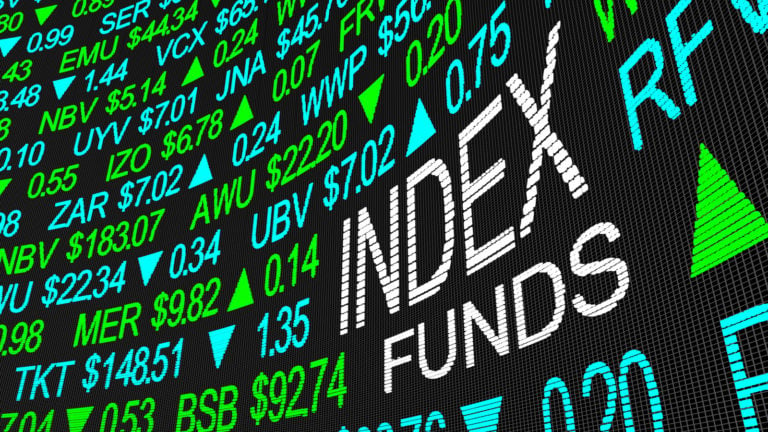As I talk about index funds to buy, investors need to understand the difference between active and passive investing. Active investing involves using the top-down or bottom-up approach to finding quality stocks. Passive investing is to invest in the index.
Why does it make sense to invest in the index?
John Bogle, founder and retired chairman and CEO of The Vanguard Group, has the answer. Bogle has advocated index investing and points to a study that “showed that 35% of managers beat the market in any single year. But the percentage falls to 25% over a 10-year period, 10% over 25 years and 5% over 50 years – an investor’s lifetime investing horizon.”
William Sharpe, who won the Nobel Prize for economics in 1990, wrote a paper on “The Arithmetic of Active Management.” He made the argument that “in any time period, the average actively managed dollar and the average passively managed dollar will get the same returns before costs. And since actively managed funds have higher costs, they will provide lower returns after costs.”
Given these observations, it’s important to have index funds in a long-term portfolio.
Let’s discuss four interesting index funds.
- Vanguard S&P 500 ETF (NYSEARCA:VOO)
- Vanguard Growth Index Fund (MUTF:VIGAX)
- Vanguard Russell 2000 Growth ETF (NASDAQ:VTWG)
- Vanguard Emerging Markets Stock Index Fund (MUTF:VEIEX)
Index Funds to Buy: Vanguard S&P 500 ETF (VOO)

With an expense ratio of just 0.03%, the VOO ETF is among the top index funds to buy. A $10,000 investment in the ETF in 2010 would be worth $36,000 now. Clearly, the index has surged in the last decade and holding the VOO ETF would have created immense value.
It’s also interesting to note that the ETF has 28.1% exposure to the information technology sector and 14.2% in the health care sector. I am bullish for the next decade as these are the hot sectors.
Apple (NASDAQ:AAPL) is the largest holding in the VOO ETF followed by Microsoft (NASDAQ:MSFT) and Amazon (NASDAQ:AMZN).
With upcoming elections and fear of a second wave of coronavirus infection, the index can be jittery in the near term. I would therefore suggest a systematic investment plan (SIP) in the VOO ETF. If an investor intends to invest $10,000 in the ETF, the investment can be spread over a period of five months.
Vanguard Growth Index Fund (VIGAX)

The VIGAX ETF is another interesting name to add to the portfolio. The ETF also has a low expense fee of 0.05%, which would imply $5 cost annually for every $10,000 invested.
The differentiating factor for this ETF is that it invests in large U.S. companies in sectors that “tend to grow faster than the broad market.”
As a comparison with the VOO, a $10,000 investment in the ETF in 2010 would be worth $46,000 now. High-growth sectors therefore trigger superior returns over the long term. This factor makes the VIGAX ETF attractive.
The ETF is overweight the technology sector with 45% holdings. With the 5G revolution, cloud computing, quantum computing and autonomous vehicles, the technology sector will remain in a high growth trajectory.
In addition, a 22.7% weight in the ETF for consumer discretionary is also interesting. A consumption driven economy and a low interest rate environment, can ensure healthy growth for the consumer discretionary sector.
Vanguard Russell 2000 Growth ETF (VTWG)

I have primarily focused on Vanguard ETFs as the expense ratio is attractive. As an example, the VTWG ETF has an expense ratio of 0.15%. The iShares Russell 2000 ETF (NYSEARCA:IWM) has an expense ratio of 0.19%. Both the ETFs invest in stocks in the Russell 2000 Growth Index.
The Russell 200 Index is considered as the “a gauge of small-cap growth U.S. stock returns.” This is the key reason to talk about the VTWG ETF.
The VTWG ETF has 33.7% exposure to the health care sector and a 17.3% allocation to the technology sector. The novel coronavirus pandemic has exposed the gaps in the health care system.
I believe that the health care sector is likely to grow at a strong pace in the coming decade. The overweight stance on the sector can be game changing for the ETF.
Since inception, the ETF has delivered an annual return of 12.45% (based on NAV). I will not be surprised if returns are equally good in the coming decade.
Vanguard Emerging Markets Stock Index Fund (VEIEX)

In the last 20 years, U.S. stocks have delivered average annual returns of 6.9%. For the same period, emerging market stocks have returned 11.2%.
In the coming decade, emerging market GDP growth will be faster than developed markets. I would not be surprised if this outperformance continues. It is therefore important to have portfolio exposure to emerging markets.
The VEIEX ETF is therefore among the list of top index funds to buy. It offers exposure to countries like China, India, Russia, Brazil and Taiwan. Some of the top holdings in the ETF include Alibaba Group (NYSE:BABA), JD.com (NASDAQ:JD), Reliance Industries and Tencent Holdings (OTCMKTS:TCEHY).
The VEIEX ETF does have a relatively high expense ratio of 0.29%. However, long-term investors can still consider exposure to the ETF given the potential emerging market stocks hold. Instead of picking stocks from different emerging markets, the ETF provides exposure to best names from several countries.
On the date of publication, Faisal Humayun did not have (either directly or indirectly) any positions in any of the securities mentioned in this article.
Faisal Humayun is a senior research analyst with 12 years of industry experience in the field of credit research, equity research and financial modeling. Faisal has authored over 1,500 stock specific articles with focus on the technology, energy and commodities sector. As of this writing, Faisal Humayun did not hold a position in any of the aforementioned securities.
